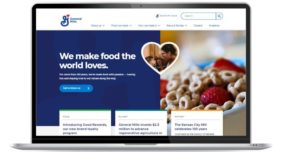A global manufacturer of storied brands like Betty Crocker, Pillsbury, and Wheaties, General Mills Inc. basks in globally dispersed online brand content that contributes to companywide sales.

Emma Wick, delivery manager for website development, General Mills
But the company recently realized its corporate brand had a story that it wasn’t telling well. By refreshing its overall brand image on a redesigned website, however, it has driven up online engagement with customers.
General Mills sought a corporate website designed to tell its story as a consumer brand manufacturer whose purpose is to bring people together around food that positively impacts their lives, says Emma Wick, delivery manager for website development at General Mills.
With food industry roots going back more than 150 years, General Mills was also due for a new website to replace its legacy platform. It took the opportunity to re-evaluate the digital experience it was offering through GeneralMills.com. The goal, Wick says, was to ensure the site met the company’s business needs and the needs of its brands; at the same time, the site also needed to tell the General Mills overall brand story effectively.
Building a more functional customer experience
General Mills and its deployment partner on the project, IT consultancy Paragon Consulting, developed a more modern site that met the needs of the consumer brand manufacturer’s diverse audience. They designed the new site with the Sitecore Experience Accelerator from Sitecore, a provider of digital experience software and related technology, to provide a more functional experience that General Mills will continue to improve, Wick says.
“Our goal was to honor the General Mills brand and General Mills as a corporation while telling the General Mills story better,” she says. “We wanted to tell the General Mills story in a better way, while still meeting the needs of our audience.”

A redesigned GeneralMills.com sharpens its corporate brand focus.
At the outset of the redesign, the General Mills and Paragon teams identified concerns they said often accompany redesigns of corporate websites. Such concerns included designing a website that balanced the story of the General Mills corporate brand and the company’s myriad consumer brands. The goal was to show how the company addresses its responsibility as a corporate citizen to the food it makes, the planet, and the communities it serves.
From a user experience perspective, General Mills sought to ensure every visitor can complete tasks on the site easily, such as finding and downloading blogs and other content. In addition, the company wanted its new website platform to provide “out-of-the-box” components that can support site enhancements on an ongoing basis.
Engaging buyers with customer-centric content
At the center of Paragon’s design strategy was taking a mobile-first approach. “Mobile is often an afterthought and we wanted to design a site that was inclusive of all mobile users,” says Matt Hummel, chief experience officer for Paragon Consulting.
Paragon’s plan also called for designing a simple information architecture, creating a customer-centric content strategy, and promoting opportunities within the site for customers to engage with the General Mills brand. In effect, telling the General Mills brand story became part of the user experience, established a framework for future personalization, and provided nuggets of information through the site Paragon refers to as “frosting,” intended to surprise and delight visitors.
From a content perspective, Paragon’s plan called for developing content curated to site visitors, whether it be articles, news stories, blogs, or press releases. The curated content also tells the General Mills story by feeding visitors dynamically changing brand content. Paragon also wanted to ensure that it was easy for visitors to consume content by gearing it to a fifth- to eighth-grade reading level.
The website infrastructure tags content so that, as visitors browse GeneralMills.com, the site dynamically feeds brand story content to them. As General Mills learns which content attracts visitors, it increases the amount of brand information shown to be relevant and personalized to each user.
Even 404 error pages are cheerful
When it comes to delighting site visitors, one example of the so-called “frosting” elements are 404 error pages within the site that deliver a “Cheeri-oh-no!” error message. The manufacturer and Paragon also saw an opportunity to develop a “G Stands for Good” section featuring articles, quotations, and videos of how General Mills is putting its customers — and the planet —at the heart of its business.
From an architectural standpoint, General Mills and Paragon developed a master repository of content items, such as photos, news, and blogs, which General Mills can share or repurpose on international and regional domestic versions of its website. GeneralMills.com is available in the United States and 30 other countries.
Other vital architectural points include creating a pattern library for all of the site’s design elements and functionality and offering guidelines for when to use or not use certain elements. General Mills says this strategy ensures a consistent user experience and sets rules for future-proofing implementations.
“We discussed all aspects of design, what components to use and when,” Hummel says. “We even backlogged a lot of features if we thought adding them would delay the launch, even if it was a cool feature. The aim was to anticipate the unexpected and make sure the design was fully understood by all in the process.”
The redesign increases performance metrics
Since relaunching the site early last year, General Mills says it has considerably improved user engagement and site performance. Lighthouse scores, a weighted average of several performance metrics based on how a website appears to visitors, improved to 90-98, up from 68-74; page views have improved by 8.9%, and session duration improved by 16 seconds, Wick says.
General Mills also learned to develop microsites for unexpected needs. For example, in July 2022, the company recalled batches of Häagen-Dazs ice cream. But it had failed to anticipate how to get recall information out to customers on the redesigned website. Wick says the IT team quickly identified the components needed to create a microsite template to create product recall pages promptly as necessary. “This was something we missed but were able to correct quickly,” Wick says.
New features on tap include adding an opportunity to chat with a General Mills representative through an Ask General Mills button and components that lead prospective employees to the human resources department.
Looking ahead, General Mills plans to be as data-driven as possible to validate assumptions and test concepts. “We want to back up our decisions with data,” says Wick.
Peter Lucas is a Highland Park, Illinois-based freelance journalist covering business and technology.
Sign up
Sign up for a complimentary subscription to Digital Commerce 360 B2B News, published 4x/week, covering technology and business trends in the growing B2B ecommerce industry. Contact editor Paul Demery at [email protected] and follow him on Twitter @pdemery.
Follow us on LinkedIn and be the first to know when new Digital Commerce 360 B2B News content is published.
Favorite